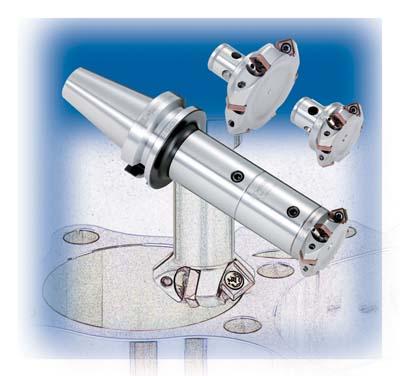
BIG Kaiser Precision Tooling Inc. has expanded the Kaiser KAB modular tooling system capabilities to include the rigid high-feed C-Cutter Mini chamfer mill line from BIG Daishowa Seiki. The new C-Cutter Mini KAB type delivers multifunctional cutting, including chamfering, back chamfering and even light facemilling. Its design permits 45°Chamfering for diameters from 0.866" to 2.441", and is suitable for use on steel (including stainless), cast iron, aluminum and other nonferrous materials. The newly introduced SE (Sharp Edge) insert type prevents burrs and is recommended for stainless and mild steel applications. The new modular connection makes the C-Cutter Mini more versatile because it can now be used with existing Kaiser KAB1/KAB3/KAB4 shanks, extensions and reductions. The KAB connection delivers performance advantages including strong face to face clamping forces for maximum rigidity, repeatable seating precision and moderate vibration dampening effect due to friction between the mating components.
Contact Details
Related Glossary Terms
- chamfering
chamfering
Machining a bevel on a workpiece or tool; improves a tool’s entrance into the cut.
- facemilling
facemilling
Form of milling that produces a flat surface generally at right angles to the rotating axis of a cutter having teeth or inserts both on its periphery and on its end face.
- milling machine ( mill)
milling machine ( mill)
Runs endmills and arbor-mounted milling cutters. Features include a head with a spindle that drives the cutters; a column, knee and table that provide motion in the three Cartesian axes; and a base that supports the components and houses the cutting-fluid pump and reservoir. The work is mounted on the table and fed into the rotating cutter or endmill to accomplish the milling steps; vertical milling machines also feed endmills into the work by means of a spindle-mounted quill. Models range from small manual machines to big bed-type and duplex mills. All take one of three basic forms: vertical, horizontal or convertible horizontal/vertical. Vertical machines may be knee-type (the table is mounted on a knee that can be elevated) or bed-type (the table is securely supported and only moves horizontally). In general, horizontal machines are bigger and more powerful, while vertical machines are lighter but more versatile and easier to set up and operate.
- modular tooling
modular tooling
1. Tooling system comprised of standardized tools and toolholders. 2. Devices that allow rapid mounting and replacement of tools. Commonly used with carousel toolchangers and other computerized machining operations. See toolchanger; toolholder.

